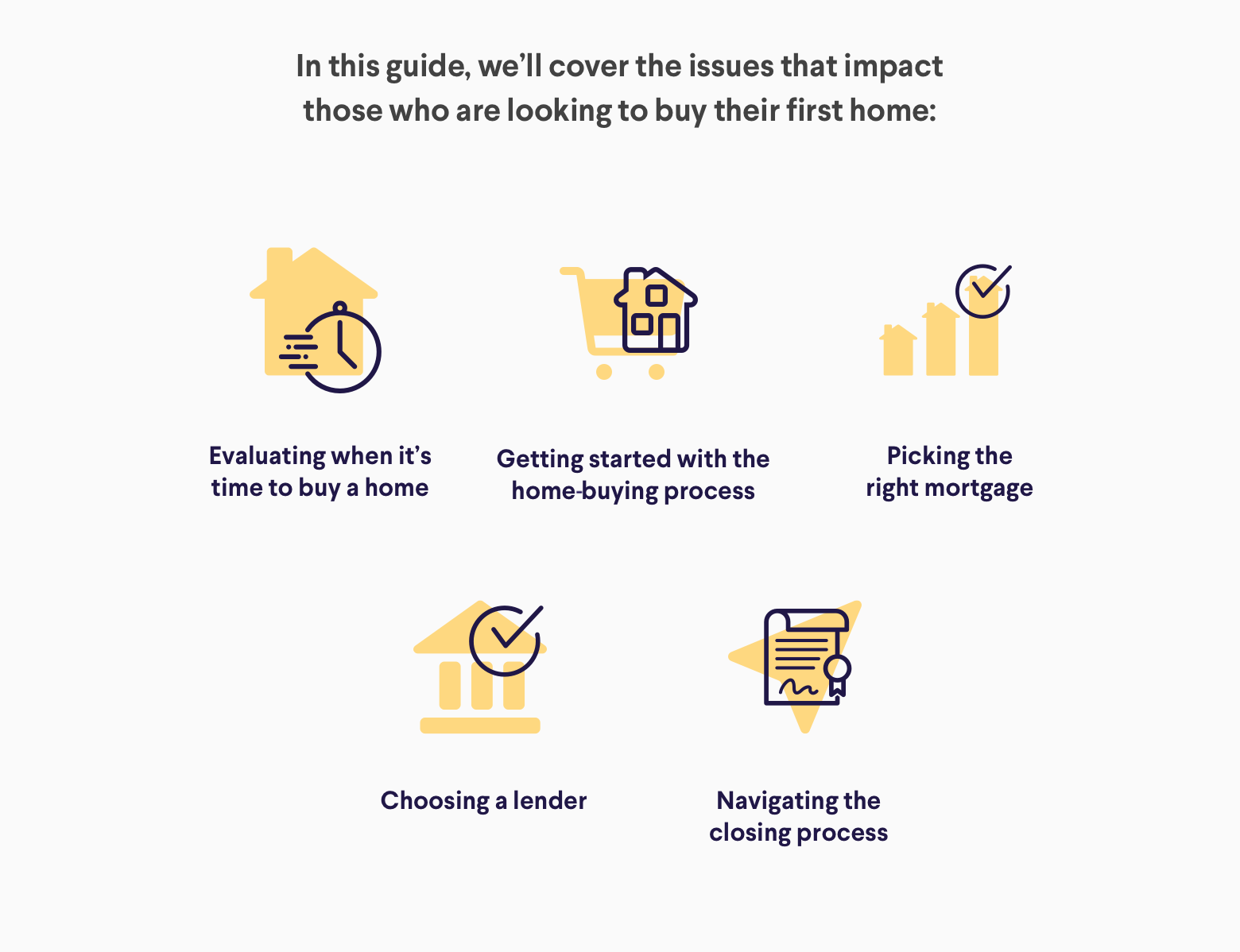First-Time Homebuyer Guide

Updated: September 6, 2024
Buying a house for the first time is a big deal. It’s as exciting as it is overwhelming!
Ultimately, buying your first home requires a mix of saving, strategy, and savvy.
We know there’s a lot to learn, which is why we created this step-by-step guide for first-time homebuyers like you. Get the knowledge you need to confidently purchase a home.
Understand the First-Time Homebuyer Advantage
First-time homebuyers often have access to down payment assistance and flexible loan qualification requirements. Who qualifies as a first-time homebuyer? Someone purchasing their very first home, sure, but also someone who has not owned a principal residence in the past three years, as well as certain other groups. So check into whether you qualify.
First-time homebuyers may be able to get a Federal Housing Administration (FHA) loan, which can have a down payment as low as 3.5%. Some other lenders also offer as little as 3% down for qualifying first-time homebuyers. You may have to pay for private mortgage insurance (PMI) or pay a mortgage insurance premium (MIP), as most lenders require one or the other when the down payment is less than 20% of the purchase price.
Helpful articles:
Figure Out if You’re Financially Ready
Maybe you’re seeking space for a home office or a growing family. Or perhaps you’re craving the community aspects of suburbia or the buzz of a vibrant, walkable city. Or maybe you’re just ready to achieve that major milestone of becoming a homeowner.
Whatever your situation may be, start with the question “Am I financially ready to buy?” before factoring in the emotional reasons for buying a home. Here are four signs you may be ready to buy:
1 Your budget is big enough to cover the down payment, mortgage payments, property taxes, homeowners insurance, and any maintenance fees. This mortgage calculator can help you visualize how much you can save on your mortgage with different down payments.
2 You plan on staying put for a while. In the early years of a mortgage, more of your money generally goes to paying down the interest than to paying off the principal. So staying in a house gives you a chance to begin chipping away at what you owe. It may also give your home time to appreciate in value.
3 You have good credit, which may lead to better loan terms.
4 Rents in your area are higher than what a house payment may be. Check out our buy or rent quiz to see where you stand.
Now you can consider the emotional perspective. Do you crave the autonomy of owning your own place? Are you dying to have control over paint colors and tile choices? Do you yearn for a second bedroom for a child, want your own garden, or need a yard for your dog?
On the flip side: Are you willing to live without your landlord (and their midnight visits to fix your broken heater)? Are you ready for a lot of responsibility?
If you’re fairly certain the time is right to buy, you’ll want to prepare to move quickly when you see a home you like. Here are three steps to make sure you are financially prepared:
1. Review Your Credit Reports
Since your financial history is a factor in getting approved for a mortgage loan (and snagging the best loan terms possible), it’s important to know what your credit report from each of the three main credit bureaus says about you.
You can look at your credit reports for free at annualcreditreport.com and catch any errors that may affect the terms lenders will offer you. Two common reporting errors are late payments and incorrect balances due on open accounts.
If you find an error, you can file a dispute with both the credit bureau and organization that provided the information to the bureau. Correcting misinformation and waiting for any adjustment to your credit score can take time, so it helps to start this step as early as possible.
Helpful articles:
2. Figure Out Your Budget
While lusting over homes online and at open houses, it’s helpful to explore just how much house you can afford. A home affordability calculator can help you estimate the cost of purchasing a home and the monthly payment.
Getting prequalified for a mortgage is another good way to test the financial waters. You’ll provide just a few pieces of information online or by phone, and a lender will estimate the loan amount you could receive. That unofficial number will help you look for homes in your range.
Helpful tools and articles:
3. Set Aside Money for a Down Payment and Closing Costs
To buy a house, you’ll need money for a down payment and closing costs, of course. But you’ll also want to budget for moving expenses, and maybe buying new furniture or sprucing up the landscaping. So grab a calculator and start drawing your financial picture
And while the decision to buy might be easy, the actual buying process can require discipline, mental fortitude, and a lot of stick-to-itiveness. So grab a calculator and start drawing your financial picture.
Helpful tools and articles:
Moving Out of State? Check the Cost of Living and Rates
Relocating away from your current hometown may change your expenses — for better or worse. Before you get your heart set on a specific location, it’s smart to check the cost of living and mortgage rates in that state.
Current Mortgage Rates by State
Prep for the Home-Buying Process
Prior to diving into an active home search, it helps to get a high-level overview of the steps involved in the home-buying process: You’ll get your finances in order and get prequalified for a mortgage; do some initial research into house types and neighborhoods; find a real estate agent to help you navigate your search; get preapproved for a mortgage; locate a home you love; bid and negotiate; have the home inspected; and close on your dream property.
Helpful articles:
Get Preapproved for a Mortgage
Unlike prequalification, which gives you a rough idea of how much money you can borrow, mortgage preapproval is a formal step, when a lender verifies your credit history, income, debt, and assets (so it helps to have your financial documents organized in advance).
This is the moment when you’ll begin to determine what kind of mortgage you want to take out. Will it be a fixed rate or an adjustable rate? How long a term?
A preapproval letter, typically good for 90 days, states that a lender is tentatively willing to lend you a specific sum for a mortgage. The letter shows sellers that you’re a serious buyer who has been vetted. That means you’re ready to act when you find your ideal home and agree on a price.
A preapproval letter is not a guarantee, though. Final loan approval rests with mortgage underwriting.
No matter your mortgage needs, SoFi is here to help.
Consider your financial goals and your long-term plans, then choose a mortgage that best supports those goals.
Get Serious About Your Home Search
Most homebuyers take on a buyer’s agent to represent their interests. The agent’s share of the commission is usually covered by the seller. As a first-time homebuyer, it really helps to have a pro on your side. You may think you know what to look for when buying a house, but a good real estate agent can also help you save money if they know the area values well and can give you negotiating advice. This may be particularly helpful if there are multiple offers on a house.
Once you’ve found a home you love and the offer is accepted, it’s tempting to want to move in as quickly as possible. But regardless of how perfect a home may seem during a casual walk-through, a home inspection is a good idea. It can identify issues that could require expensive repairs down the line. Lenders don’t require an inspection, but including a home inspection as a contingency clause when you present your offer is considered a smart move.
The inspector will typically assess the plumbing, mechanical systems, and the structure of the home. Once the inspection is complete, you should receive a report within a couple of business days. With this information in hand, you may be able to go back to the seller to further negotiate the price of the home and necessary repairs.
Most mortgage lenders will require an objective property valuation after the seller has accepted an offer. The buyer pays for the appraisal ordered through the lender.
Helpful articles:
Finalize Your Mortgage
As you move into the final phase with your mortgage lender, you can ensure the home mortgage loan terms suit your finances and plans for the future.
A fixed-rate mortgage has an interest rate that stays the same for the entire term of the loan, regardless of fluctuations in the broader economy. Generally speaking, these loans have a higher interest rate than the introductory rates on most adjustable-rate mortgages (ARMs).
An ARM is so named because the interest rate can fluctuate over time. ARMs often start out with a fixed rate that is adjusted after an initial period, typically three to 10 years. The lower introductory interest rate is attractive to many buyers, but in signing onto an ARM, you are taking the risk that interest rates might rise after your introductory period.
A third option, the interest-only mortgage, is less common with first-time homebuyers. These mortgages give borrowers the option to pay only the interest on the loan each month for a period of, say, five to 10 years. At that point, the loan converts to a standard structure in which principal and interest are paid monthly.
Close and Celebrate!
• The escrow company/closing agent will calculate legal fees, transfer taxes, and closing costs, as well as coordinate the transfer of ownership via the deed.
• The lender provides documentation of the loan, including the note, the mortgage, closing fees, and other disclosures.
• The title company will furnish documentation of clear ownership in the form of a title insurance policy.
Before closing, you will need to schedule a final walk-through to ensure that any agreed-upon repairs have been completed and the home has been left in satisfactory condition. You’ll receive a closing disclosure three or more business days before the loan closing for review of fees and terms. If everything checks out, you and the sellers will sign the closing documents.
After the documentation and all financial transactions have been verified as complete by the escrow company or closing agent, the escrow company will record the change of ownership with the county and you will be given the house keys.
Helpful articles:
The Takeaway
Buying your first home can be nerve-wracking, but programs are available to make homeownership feasible for first-timers, even if you aren’t sitting on a giant nest egg for a down payment. With some smart shopping — for both a house and a mortgage loan — you’ll be on your way in no time.
Looking for an affordable option for a home mortgage loan? SoFi can help: We offer low down payments (as little as 3% - 5%*) with our competitive and flexible home mortgage loans. Plus, applying is extra convenient: It's online, with access to one-on-one help.
FAQ
What are the steps of buying a house?
Everyone’s experience is unique, but generally, the process starts with calculating how much house you can afford, saving up for a down payment, and familiarizing yourself with the market. Then, you can go to a lender to get preapproval on a mortgage. With your preapproval letter in hand, you can start shopping. Once you’ve submitted an offer on the home you want, you can finalize your mortgage, get a home inspection, and close on the home.
What do I need to know before buying a house for the first time?
It’s important to know what you can afford, taking into consideration not only the upfront costs (down payment, closing costs, etc.) but also the long-term costs (including mortgage payments, property taxes, and home repairs). Compare home mortgage loan rates carefully. Find a real estate agent who understands your goals and budget to help you along the way.
What is the first step to buying a house for the first time?
The first step is figuring out how much house you can afford, based on how much money you have saved, your income, and current debts.
How much money should you have to start buying a house?
You’ll want to have saved at least 3% — and ideally up to 20% — of your estimated purchase price of a new home. This is your down payment. You’ll also need a cushion for closing costs. Don’t drain your entire savings: It’s still wise to have at least 3 to 6 months of living expenses saved in case of an emergency.
What is the best way to buy a new house?
The best way to buy a new house is with patience and prudence. Take time to calculate how much you can realistically afford in the long term. Get prequalified for a mortgage to know what rate you might qualify for, seek preapproval for a home loan, and get the home inspected before closing on it. Your perfect home is one that checks your most important boxes without creating financial stress.
Ready to get started?
Learn more about SoFi Home Loans today.
We’ll help you discover whether this year is the year you make your dreams of homeownership a reality.
*SoFi requires Private Mortgage Insurance (PMI) for conforming home loans with a loan-to-value (LTV) ratio greater than 80%. As little as 3% down payments are for qualifying first-time homebuyers only. 5% minimum applies to other borrowers. Other loan types may require different fees or insurance (e.g., VA funding fee, FHA Mortgage Insurance Premiums, etc.). Loan requirements may vary depending on your down payment amount, and minimum down payment varies by loan type.
SoFi Loan Products
SoFi loans are originated by SoFi Bank, N.A., NMLS #696891 (Member FDIC). For additional product-specific legal and licensing information, see SoFi.com/legal. Equal Housing Lender.
SoFi Mortgages
Terms, conditions, and state restrictions apply. Not all products are available in all states. See SoFi.com/eligibility-criteria for more information.
Financial Tips & Strategies: The tips provided on this website are of a general nature and do not take into account your specific objectives, financial situation, and needs. You should always consider their appropriateness given your own circumstances.
SOHL0623014
















































